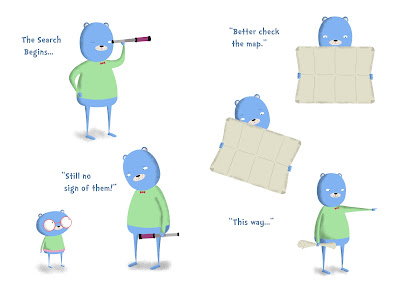After much blogging around the subject of working
on my 'Final Major Project', it occurs to me that I have yet to post any of the
actual work itself. Well, now you can see for yourself what all the fuss has
been about. It's taken me a while to get to this point. It has taken numerous
character designs for the two main protagonists. Numerous background designs
for the world in which they inhabit. It has taken a lot of experimenting with
various styles to use for the book. I've tried using block print textures,
charcoal, pencil, and crayon. I've tried creating it all digitally, then when
that seemed too artificial tried the opposite only to find that a compromise
between the two was the best way.
I think most people would agree that I spent too
much time worrying over little insignificant details of the designs, like if
both bears should be wearing glasses, or what colours their clothes should be,
or if I should draw each individual hair. The list goes on, and I don't like to
think about all the time I have spent worrying over how I should do the
shading, or if there should even be shading, how dark should it be.
Its fair to say that some of this time could have
been better served, perhaps on the animation, perhaps even on updating this
blog more often. Either way the important thing for now is the work is done and
I am pleased with it. For the most part that is. When I look at it I still see
my mistakes and can't help but think of things I would like to have done
differently. But then, I think most of my classmates feel the same way when
looking at their 'Final Major Projects', we have to accept that we will never
be totally satisfied, we just have to be content in the knowledge that we have
done as well as we can.
So, here it is, see what you think:



































